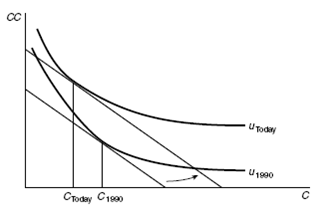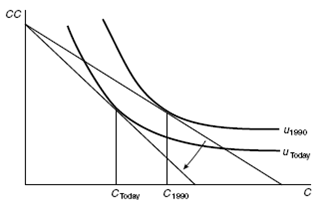Since 1990, real income has increased rapidly, yet the average number of children per family has decline." Three possible explanations for this process are given below. Explain each of them using indifference curves and budget lines showing the tradeoffs between the composite commodity (CC) and number of children. Also give a verbal explanation.
a. Children are an inferior good; parents demand, as income rises fewer children.
ANSWER: As given below, as income rises, the budget line gear up and the new optimal choice happens at the point of tangency between the highest indifference curve and new budget line. Since children are an inferior good, the quantity of children after the income increase will exceed the quantity of children before the income increase.
b. Children are basic goods but they have become more expensive to raise.
ANSWER: As explained below, an increase in the cost of raising children can pivot the budget line so that fewer children will be afforded if the entire income is used on children. The substitution effect may cause fewer children to be raised. The income effect can work in the same direction - a lower real income because of the increase of the cost of raising children will cause fewer children to be raised.

c. Children are not more expensive; the tastes of parents have modified, such that children are less preferred now than they were in 1990 ".
ANSWER: As explained below, a modification in tastes will modify the position and shape of the indifference curves - indifference curve will become flatter for each level of C. Thus, for a given budget line, fewer children will be raised.
